Description
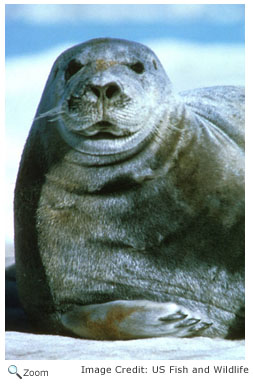 The bearded seal is a large seal that is 7-8 feet in length. It is at its heaviest during winter and early spring, when it can weigh as much as 750 pounds. In the summer and early fall, it usually weighs 475 to 525 pounds. The female is a little larger than the male. The bearded seal is a large seal that is 7-8 feet in length. It is at its heaviest during winter and early spring, when it can weigh as much as 750 pounds. In the summer and early fall, it usually weighs 475 to 525 pounds. The female is a little larger than the male.
The bearded seal has gray to brown fur and squared-off front flippers with strong claws that it uses to open breathing holes in the ice. It has a round head; small eyes; and and a large, wide muzzle with bristly white whiskers.
Bearded seal pups may have a black stripe running up the middle of their forehead.
Range 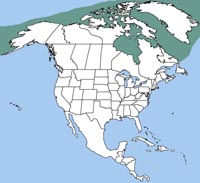 In North America, the bearded seal is found in northern coastal waters and shallow seas from Alaska to Labrador, Canada and Greenland. It has a circumpolar range and is also found in northern coastal arctic waters of Europe and Asia. In North America, the bearded seal is found in northern coastal waters and shallow seas from Alaska to Labrador, Canada and Greenland. It has a circumpolar range and is also found in northern coastal arctic waters of Europe and Asia.
Habitat
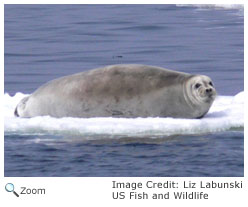 The bearded seal prefers shallow arctic waters less than 500 feet deep. It is found on patches of floating ice. In the summer months, it may climb onto rocky beaches. The bearded seal prefers shallow arctic waters less than 500 feet deep. It is found on patches of floating ice. In the summer months, it may climb onto rocky beaches.
| |
Diet
The bearded seal uses its sensitive whiskers to locate prey like fish, crabs, shrimp, clams, and snails.
Life Cycle
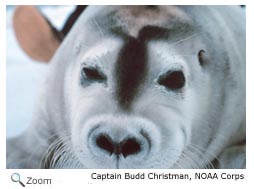 The bearded seal mates in May. Groups of up to 50 bearded seals may gather together. Males sing to attract females and males occasionally fight over a female. The female gives birth to a single pup 11 months after mating. The pup weighs about 70 pounds at birth. Its eyes are open, and it is covered in blue to brown fur. The pup swims shortly after birth and quickly puts on weight. It nurses for 12 to 18 days. By the time the nursing period is over, it will have almost tripled its weight to about 185 pounds. The female mates again two weeks after her pup is weaned. The bearded seal mates in May. Groups of up to 50 bearded seals may gather together. Males sing to attract females and males occasionally fight over a female. The female gives birth to a single pup 11 months after mating. The pup weighs about 70 pounds at birth. Its eyes are open, and it is covered in blue to brown fur. The pup swims shortly after birth and quickly puts on weight. It nurses for 12 to 18 days. By the time the nursing period is over, it will have almost tripled its weight to about 185 pounds. The female mates again two weeks after her pup is weaned.
Behavior
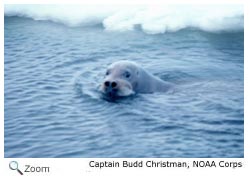 Except for the breeding season, the bearded seal is a solitary animal. In the spring, male bearded seals "sing" underwater songs that can be heard by humans on the surface! The song is probably used to attract a mate and establish territory. Except for the breeding season, the bearded seal is a solitary animal. In the spring, male bearded seals "sing" underwater songs that can be heard by humans on the surface! The song is probably used to attract a mate and establish territory. |



 In North America, the bearded seal is found in northern coastal waters and shallow seas from Alaska to Labrador, Canada and Greenland. It has a circumpolar range and is also found in northern coastal arctic waters of Europe and Asia.
In North America, the bearded seal is found in northern coastal waters and shallow seas from Alaska to Labrador, Canada and Greenland. It has a circumpolar range and is also found in northern coastal arctic waters of Europe and Asia.

